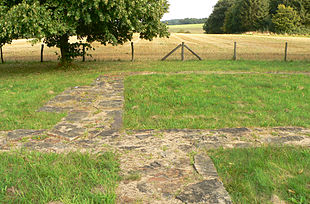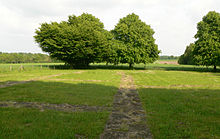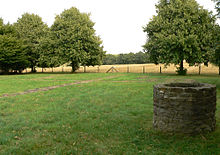Asbeke Abbey
The pin Asbeke is a abgegangenes pin in the rehburg hills in Rehburg . The construction of the medieval church complex in the 11th century is attributed to the Archbishop of Bremen, Adalbert . The monastery was related to the extraction of building material for the Bremen Cathedral . The remains of the monastery complex were discovered in 1979 while plowing in a field, whereupon the Institute for Monument Preservation from Hanover carried out an excavation .
location
The church complex was about two kilometers southwest of Rehburg on the eastern slope of the Rehburg Mountains below the Loccumer Berg. Today's Asbeke desert was located nearby . The elevated location allowed a wide view over Rehburg to the Steinhuder Meer . A few hundred meters from the site of the former church is an abandoned quarry . There is sandstone from the Lower Chalk with embedded limestone banks .
discovery
The remains of the monastery were discovered in 1979 by a farmer and local researcher from Rehburg. After sandstones and mortar regularly surfaced during plowing, he dug in the field and came across wall foundations. He immediately reported his discovery to the Institute for Monument Preservation in Hanover, which carried out archaeological investigations in annual excavation campaigns from autumn 1979 to 1982.
Source research
The discovery of the remains of the foundations of a larger building complex in 1979 led, in addition to the excavation, to the search for historical records of the object. Based on the floor plan, it was possible to infer a church building, whereby a monastery was to be excluded based on the traditional forms of construction. Therefore a collegiate church was assumed. Since there were no records of an earlier church near Rehburg in local and regional archives in Rehburg and in the Loccum monastery , the source research concentrated on the Asbeke desert in the vicinity of the site. It is mentioned several times in documents from the 12th to the 14th century. Since the last mention of 1407 only deals with the land of Asbeke, it is assumed that the settlement was abandoned as early as the 14th century during the late medieval desert period . The residents are likely to have moved to the nearby Rehburg, which had formed around Rehburg Castle from 1320 .
In the course of further research, Asbeke was mentioned in the history of the bishops of the Hamburg church , which Magister Adam von Bremen had recorded in the 11th century. Accordingly, Asbeke was a place and a provost in the "forest mountains of the diocese of Minden ". It was one of a series of provosts that Archbishop Adalbert von Bremen founded during his tenure from 1043 to 1072. According to tradition, the monastery building collapsed while he was visiting. Presumably, due to the incident with a presumably strong psychological effect, the pen did not have a long service life. According to a later mention, the Archbishop of Bremen Liemar stayed in Asbeke to procure building lime for the Bremen Cathedral . In 1092 Asbeke is mentioned in the sources in connection with the procurement of lime, although there is no longer any mention of a pen. The Bremen bishops had sandstone broken in the Rehburg mountains until the 13th century. In this context, Asbeke is mentioned for the last time in a document from the 13th century, when the Archbishop of Bremen Hildebold left goods in Asbeke, apart from a quarry, to the Loccum monastery.
Building description
The main building of the monastery was an elongated hall building divided into three areas, which is regarded as a church building. A rectangular choir was attached to it. In the construction, the masonry of the main building was neatly worked. Several small buildings were attached to the choir, in which the living quarters of the clergy are assumed. They were less thorough, with defects in the construction, which suggests a change in the construction management. On one side, the complex has a walled area that is viewed as a courtyard. A fountain was located a few meters from the buildings.
The uncovered foundations extend over 45 by 25 meters, whereby not the entire building complex has been exposed. A wall foundation traced in the ground extended 37 meters from the building complex. As a result of the excavation, the remains of the ground were assessed as the ground plan of an early Romanesque monastery.
rating
The monastery founded by the Archbishop of Bremen in the area of a foreign diocese not only served spiritual purposes, but also had an economic background. As a permanent presence, the monastery secured the extraction of building material in the form of sandstones and lime, which were mined in the Rehburg mountains for the construction of the Bremen Cathedral. It is not known how the material was transported to Bremen. Land transport over several kilometers to the Weser or ship transport on the Meerbach flowing through Rehburg , which flows into the Weser at Nienburg / Weser, is conceivable .
presentation
After the excavation, the arable land with the remains of the Asbeke Abbey was purchased with public funds. Since then, the site has been open to the public as an archaeological monument . The original wall foundations were partially covered with sandstone slabs to ensure visibility and to protect against weather influences. The discovered well was bricked up later. An information board shows the historical background of the facility.
literature
- Ernst-August Nebig: The archaeological riddle of Rehburg. The disappeared "Stift Asbeke" A failed foundation from the Middle Ages.
- Hans-Wilhelm Heine , Norbert Steinau: The Asbeke Abbey on the Rehburger Mountains: A failed foundation by Archbishop Adalbert of Hamburg-Bremen around the middle of the 11th century , in: Niedersächsisches Jahrbuch für Landesgeschichte , 1986, pp. 279–287 ( online , P. 253, 60.3 MB)
Web links
- Reconstruction drawing in the medieval state
- Description of the pen and the place where it was found
- Newspaper report on Asbeke Abbey in the Wunstorfer Stadtanzeiger from July 31, 2008
- Photos of the plant with aerial view
Individual evidence
- ↑ Adami Bremensis: Gesta Hammaburgensis ecclesiae pontificum , (Adam von Bremen: Bishop's History of the Hamburg Church ) in: Sources of the 9th and 11th Centuries for the History of the Hamburg Church of the Reich , Vol. 11, 1968, p. 338
- ↑ see literature: Hans-Wilhelm Heine, Norbert Steinau: Das Stift Asbeke on the Rehburger mountains , result, p. 287
Coordinates: 52 ° 27 ′ 31.3 " N , 9 ° 12 ′ 35.7" E


